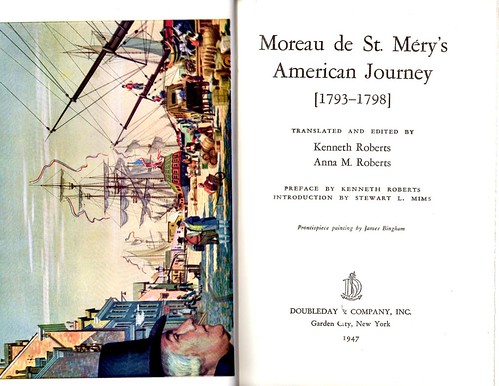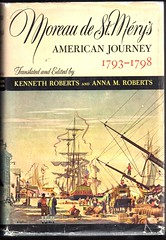
PREV ARTICLE
NEXT ARTICLE
FULL ISSUE
PREV FULL ISSUE
BOOK REVIEW: MOREAU DE ST. MÉRY’S AMERICAN JOURNEY
Gawain O'Connor submitted this review of a book he recently discovered which should hold interest for anyone curious about the use of
coins and money in early America. Thanks! -Editor
Médéric Louis Élie Moreau de Saint-Méry (1750–1819), a Creole colonist born in Martinique, was best known for his publications on that island as well as Saint Domingue. During his stay in the United States he was a bookseller and printer and the first to sell condoms. His diary includes prices for everyday items and a brief description of the Philadelphia mint in 1795: The Mint There is one of these in Philadelphia, but it is not busy, because the chief money is piaster gourdes. There are still only a very few eagles worth ten gourdes, half eagles worth only five, and quarter eagles worth only two and a half. Thus the Mint, as one might say, is merely a curiosity. [pp. 358-9] But what I found most fascinating was the translator’s (Anna M. Roberts) footnote on that page: A piaster gourde was a San Domingan coin worth one dollar. A writer once advanced the theory that the word “shin-plaster” came from the habit, in colonial days, of protecting the legs from the heat of open fires by wrapping the shins with Continental bills. Actually “plaster” came from “piaster”; “shin” came from “chien”: dog money. I had never heard that etymology before – shinplaster = dog money. Is it attested in any coin books? There are some other gems in the book. C4 members might like this one: Hackensack ferry Ordinary travelers (and those not riding in the stage) pay when they leave the second ferry. The fare is one forty-fifth of a dollar per person, two sous, one thirtieth for a horse, three sous. Here we have seen paid for the same cabriolet, two horses and three men, five sixteenths of a dollar, three sous. Here, too, we were witnesses of a remarkable scene between a passenger and the woman who collected the fares, who was young, pretty and had an expression of angelic sweetness. Having been given in payment one of those copper half-sous coined by the state of Jersey, she refused it obstinately and became furious, declaring with the most expressive words, that she didn’t give a hoot for the Assembly of New Jersey, whose members were no better than she and couldn’t make her take the money. [p. 117] Here are prices for the principal things: Milk (which is abundant) costs 1/16 of a dollar a pint. Cider costs 1/16 of a dollar a pint. A pound of meat 1/10 of a dollar a pound if one picks it out, 1/16 of a dollar not selected. Mutton ¾ of a dollar for a hindquarter. Veal is scarce, and costs 1/12 of a dollar a pound. A suckling pig ½ dollar. Eggs from ⅛ of a dollar to 3/16 for a dozen. Green peas ⅛ of a dollar a bushel. Butter 3/16 of a dollar the pound or ¼ of a dollar. Vinegar 1/16 of a dollar the pint. Potatoes ½ dollar a bushel, down to 5/32. Sweet potatoes from a dollar a bushel down to 3/16 of a dollar. Lard 1/6 of a dollar a pound. French bread 1/16 of a dollar for 10 American ounces. Candles, 5 pounds for a dollar. Men’s shoes, 2 dollars a pair. Short boots, 5 dollars a pair. Boots 7 dollars a pair; with double vamps 8 dollars. A workman by the day, in 1792, ½ dollar; at the end of 1792, 9/16 of a dollar; in 1793, 5/8 of a dollar, then 11/16; in June, 1794, ¾ of a dollar. Between 1792 and 1794 a workman’s pay went from 1 dollar to 5/4 of a dollar. [$1.25] A sailor 1 dollar and ¾ a day. People paid by the day worked from six in the morning to eight; from nine to noon and from two to six. [9 hours] and so on… [starting p. 157] 
I wasn't aware of this book, and it seems like a marvelous find for numismatists. Of course, there are untold documents and accounts
available in archives and elsewhere that may never have been consulted by numismatic researchers, or at least not reviewed by anyone in
decades. All are worth a fresh look. Many thanks to Gawain for bringing this to our attention. -Editor
Wayne Homren, Editor The Numismatic Bibliomania Society is a non-profit organization promoting numismatic literature. See our web site at coinbooks.org. To submit items for publication in The E-Sylum, write to the Editor at this address: whomren@gmail.com To subscribe go to: https://my.binhost.com/lists/listinfo/esylum All Rights Reserved. NBS Home Page Contact the NBS webmaster 
|
